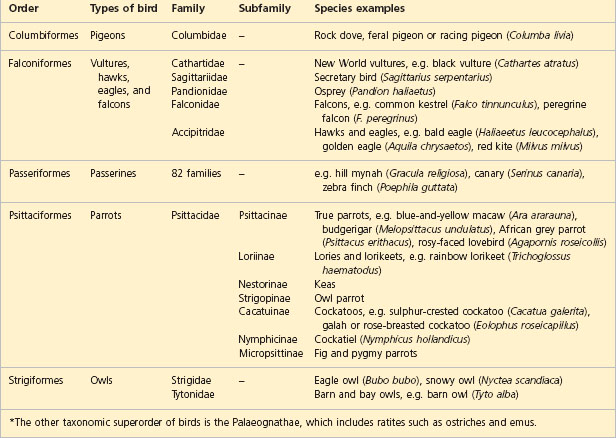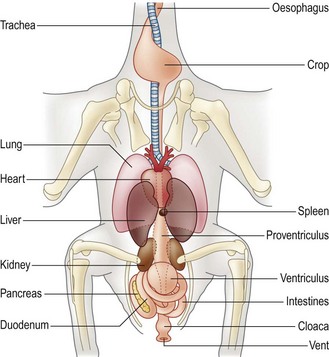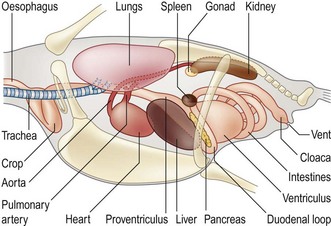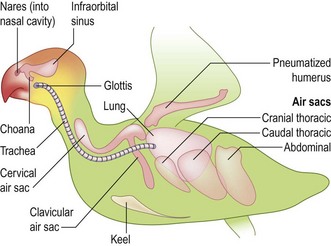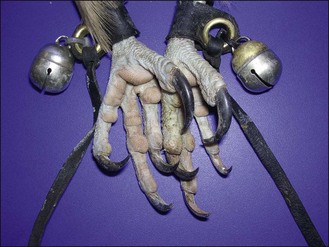9 Birds – an introduction
Biology
Basic internal anatomy for birds-including gastrointestinal, respiratory and cardiovascular – is given in Figs 9.1–9.3.
Psittaciformes
African grey parrot (Psittacus erithacus)
Although free-ranging birds eat a large amount of nuts and seeds, over-feeding of these foodstuffs in captivity results in malnutrition due to differing energy requirements (lower in captive animals). It is advisable to feed a proprietary pelleted diet, supplemented with fresh fruits and vegetables (10% of the diet), and some sprouted pulses (Box 9.1). Grit may help with digestion. Vitamin and mineral supplements may be additionally required, particularly for breeding birds (Box 9.2). Fresh water should be provided in a bowl for drinking; many birds also appreciate a shallow water container for bathing.
Budgerigar (Melopsittacus undulatus) and cockatiel (Nymphicus hollandicus)
Captive diets may include small seed mixes, although commercial formulated pellets are better balanced. Fresh green food (e.g. chickweed, dandelion or lettuce leaves), small amounts of fruit, and cuttlefish bone should be provided. Vitamin and mineral supplementation is advised if the bird is on a seed diet (Box 9.3).
Passeriformes
Canary (Serinus canaria)
These small birds (10–40 g) originated from the Canary Islands. Housing is similar to budgerigars.
Falconiformes
Birds are either kept tethered or housed in an aviary (Box 9.4). Tethered birds are attached to a perch by a leash (Box 9.5) during the flying season (typically winter for hunting and summer for birds used in public demonstrations), and normally moved to an aviary during the close season for moulting. Some birds may be ‘free-lofted’ (being housed in and flown from aviaries), in particular vultures that may find tethering stressful. Substrates in enclosures vary from bare earth to gravel to bark chip; all should be hygienically maintained to reduce the risk of disease.
Strigiformes
These carnivorous birds are usually fed once daily (as are falconiformes). They do not possess a crop, and, as bones are not digested, cast material includes fur, feathers and bones from prey. Sexual dimorphism is slight in the main, although obvious in some species such as the snowy owl (Fig. 9.5).
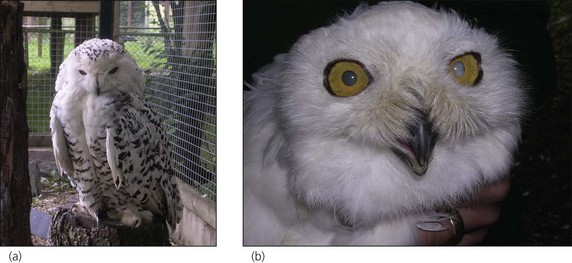
Figure 9.5 Snowy owl. (a) The female has brown flecks on her ventral feathers whereas (b) the male is white.
History
Although a full clinical examination is possible on most medium- to large-sized birds, it is still important to take a full history (see Box 9.6). Husbandry changes or inadequacies commonly contribute to disease. In addition, companion birds are often prey species and will hide signs of illness, so any clinical changes seen may be subtle.
BOX 9.6 Suggested topics to cover during history taking for birds
Stay updated, free articles. Join our Telegram channel

Full access? Get Clinical Tree


